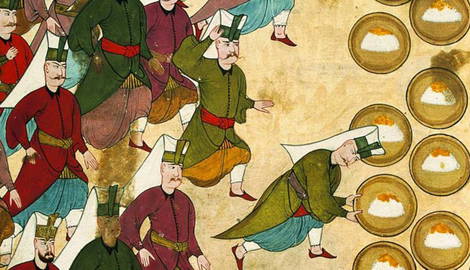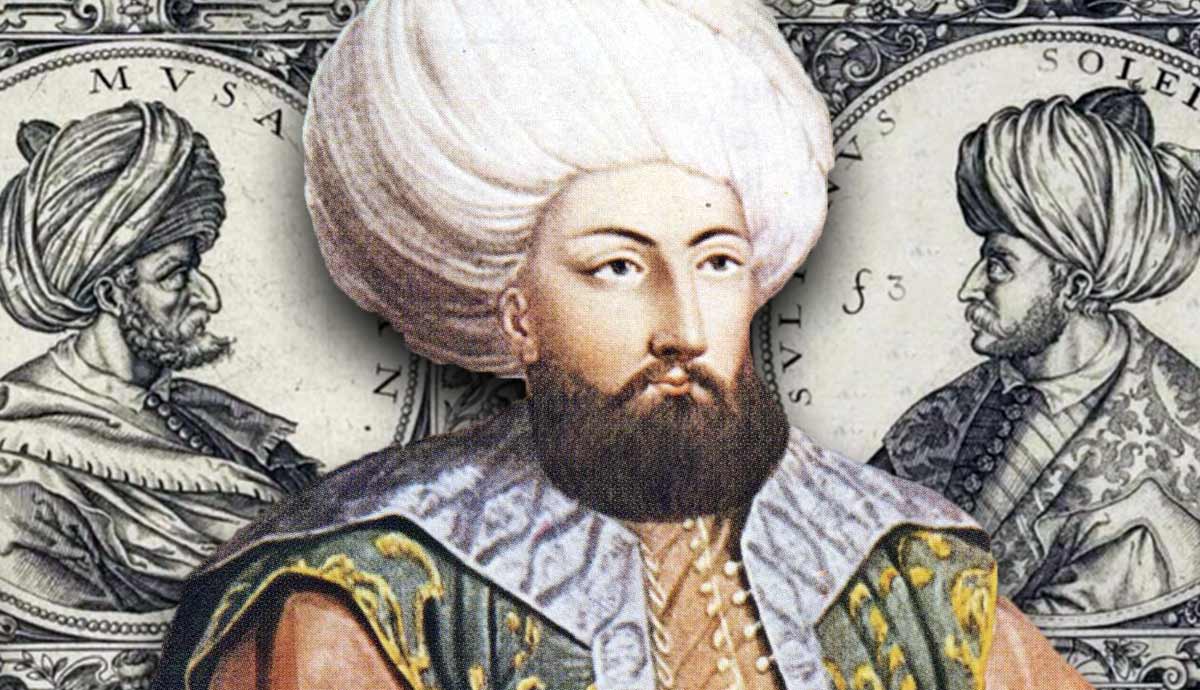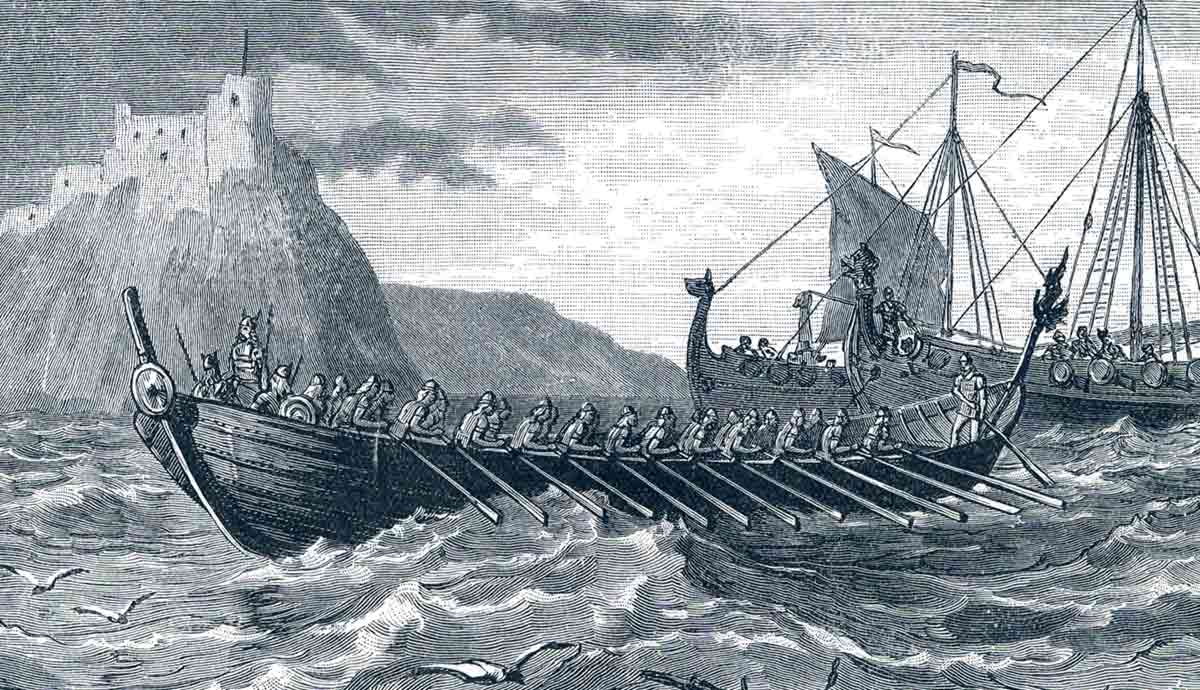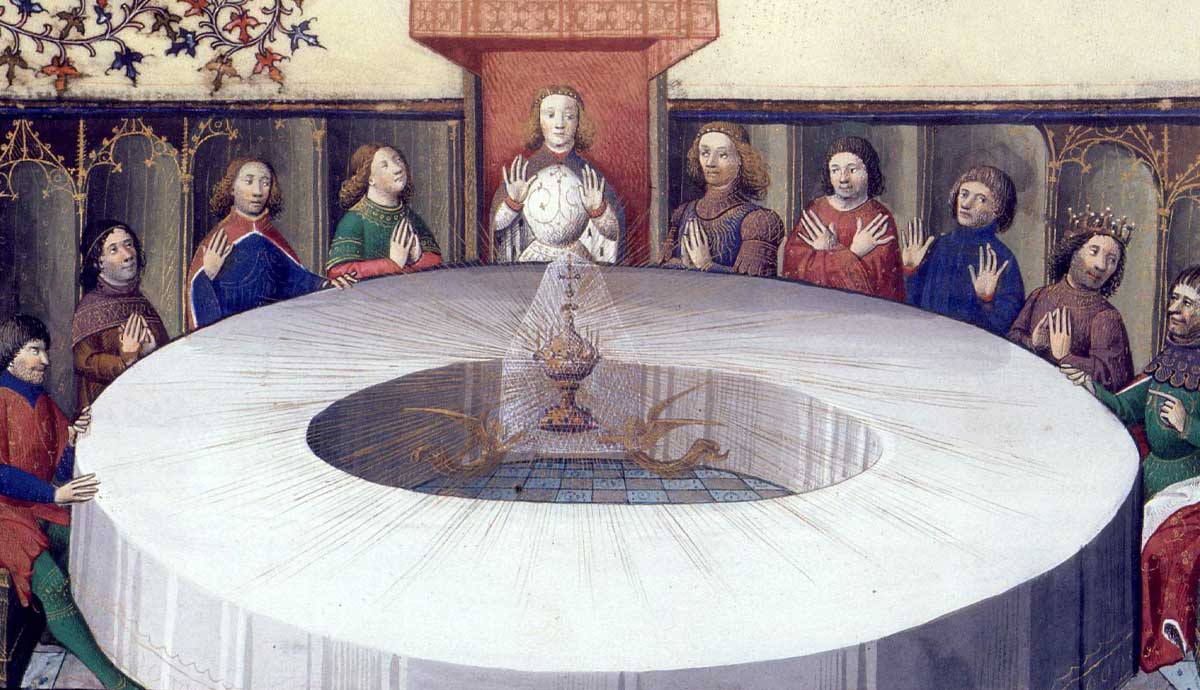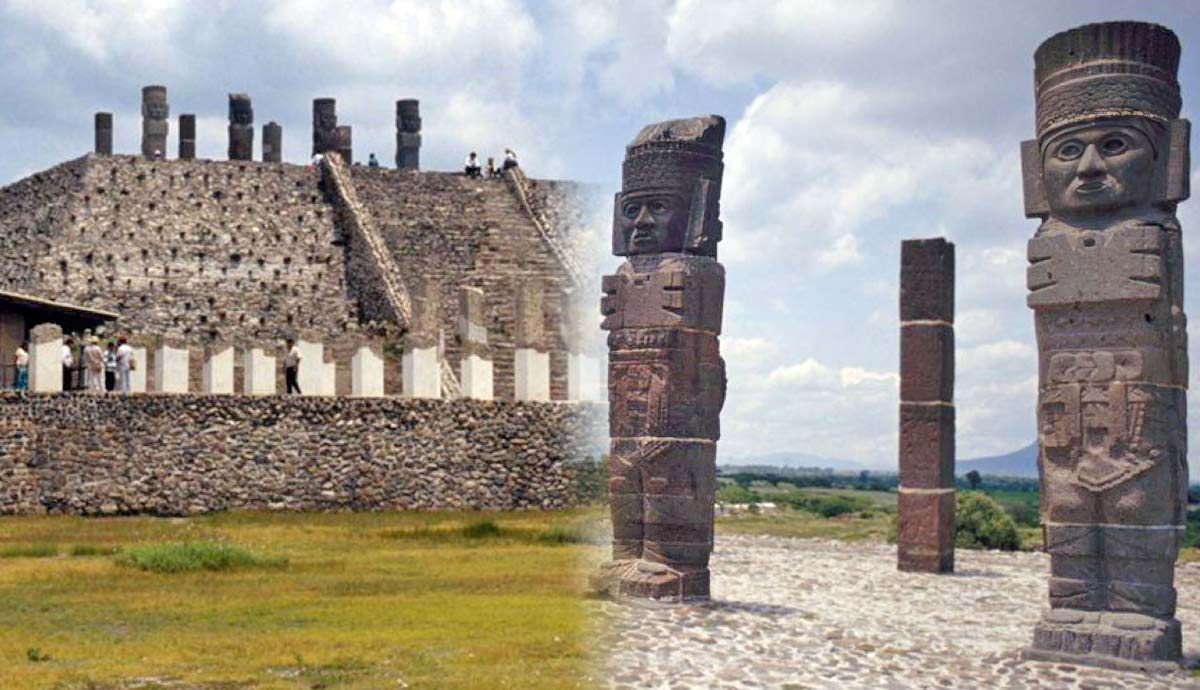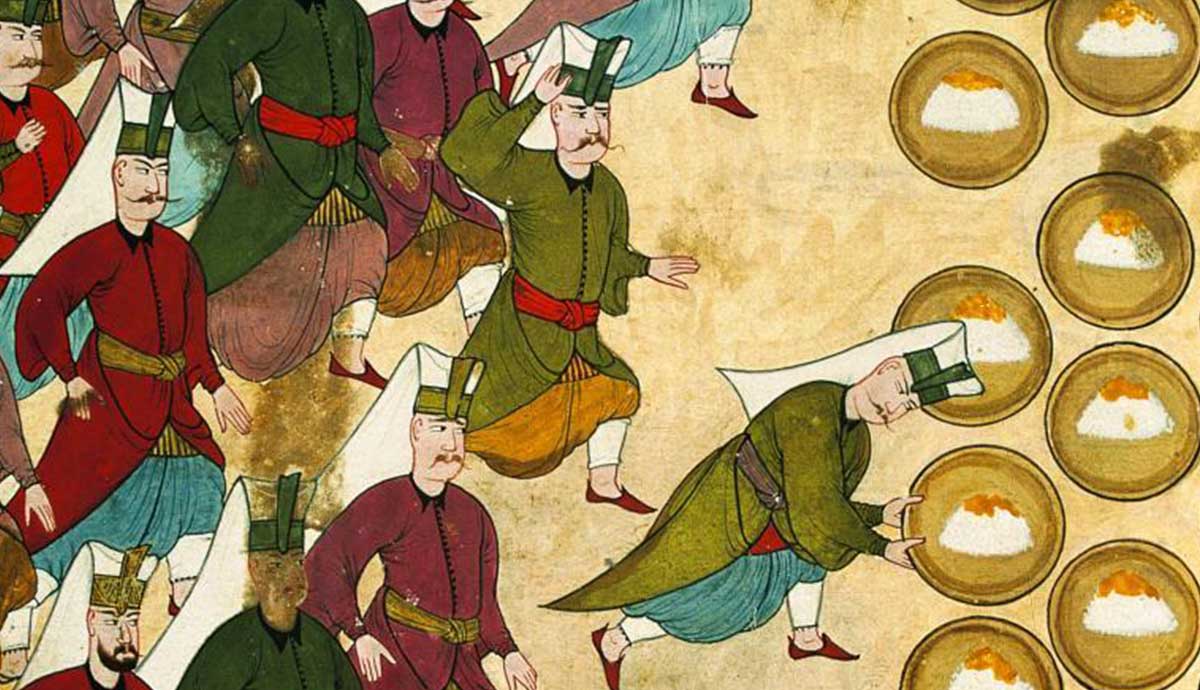
In the 15th and 16th centuries, the Ottoman palace kitchens were places where delicious and innovative foods emerged. A sultan’s personal tastes, whether leaning towards savory or sweet, influenced the culinary culture of the court. Some of the sultan’s favorite foods, like Baklava, also found their way into wider Turkish cuisine.
Medieval Manners

The Ottomans emerged in late 13th century Turkey as a frontier-dwelling nomadic clan. Like other Turkic tribes, their culinary culture was suited to the realities of a pastoralist lifestyle. Animal products like meat and dairy were the staples of their diet, though unleavened flatbreads were also eaten daily. Nomadic warriors—such as the feared horse archers—who had an exalted status in the clans were also expert hunters. They provided their tribespeople with meat from wild animals like deer.
Like in medieval Mongol culture, the nomadic Turks also survived on fermented milk products like yogurt. In fact, the word itself derives from the Turkish word yoğurt, which in turn is related to the verb yoğurmak, meaning to thicken or curdle. Nomads not only ate these foods but also traded them for other goods in markets around the growing Ottoman principality. Soon, agricultural products like bulghur wheat became an important part of their cuisine.
As the Ottoman chiefs (called beys) transitioned into sultans in the 14th century, they also began to adopt the culinary features of sedentary life. Cooked fruits and nuts were incorporated into cooked meats for the sultans to enjoy. In the late 15th century, the Ottoman sultans also began to eat with finer materials like porcelain and silver, as opposed to the bone or wood that their tableware was made of in earlier times.
Today’s Menu!

The Topkapi Palace had several areas reserved for cooking. These included the helvahane, the imperial dessert kitchen, and the Kushane, the special kitchen where the sultan’s meals were prepared. Meals were cooked meticulously and punctually, as the royal eating schedule was strict. In the 15th century, food was prepared twice a day; breakfast was eaten in the early hours of the morning, and dinner around four to five pm.
The palace kitchens had a colossal number of staff to accommodate the sultan, his family, and other inhabitants and visitors of the palace. Approximately 800 kitchen staff were employed to cook for 4,000 people! Cooks were required to rise in the early hours of the morning to have food ready by sunrise when the morning prayers were held.
A variety of ingredients were used to make interesting combinations for the sultan. Plums and pomegranates were brought specially from cities like Bursa to make a sour paste or marmalade called Nardenk.
Unlike the Turkish populace, the Ottoman sultan also had access to a variety of spices like cumin, saffron, and cinnamon, which were put into pilav (rice), et (meat) or tatli (sweet) dishes. Lamb and beef stew were cooked with fruits like plums, apricots, and pomegranates. This also differed from the cuisine of the common folk, who did not mix sweet and savory ingredients.
The Conqueror’s Seafood

Sultan Mehmed the Conqueror (r. 1451-1481) was an avid seafood eater. Some historians speculate that this may have been introduced to his court after his conquest of Constantinople in 1453. Mehmed incorporated many aspects of Byzantine culture into his court and the increasingly sedentarized empire. Seafood like prawns—which were eaten by the Greeks of Constantinople—are a recurring dish in the palace menus of the late 15th century. This signaled a change from the nomadic pastoralist diet of mainly meat and dairy.
In 1460, the Topkapi Palace was built in the new imperial capital of Constantinople (Istanbul). The palace was modeled on the old palace in Edirne, which had housed almost 800 people. The sultan’s food was cooked in a separate area from the main kitchen. At the entrance of the harem was a small cookery called the Kushane, where the sultan and royal family’s food was prepared. While he initially ate with courtiers, later in his life, Mehmed preferred to eat alone.
Food products were brought from all around the empire to accommodate the sultan’s tastes. Mehmed II enjoyed fish, and so, freshwater fish was brought from Terkos Lake (modern-day Durusu), an occasional recreation and rest spot for the sultan.
While on campaigns, however, the sultan’s diet changed once again. Instead of heavier products like meat and dairy, Mehmed consumed more fruit, vegetables, and bread. Soup was also a popular campaign meal—it was probably easier on the sultan’s stomach during hours of traveling on horseback!
Gluttony and Gout

Although the official court records show that the kitchens operated twice a day, the sultan could technically request a meal whenever his heart desired. After a three or four-course meal, the sultan would usually have a sweet treat. This could be halva, a dessert made of flour and butter, or baklava, a layered pastry filled with nuts and covered in syrup. Şerbet, a sweet, cordial-like drink made of flowers or fruits, was also a staple of the sultan’s dinner table. Full of sugar and honey, Şerbet was always served, be it an official meeting with a vizier, or during the sultan’s recreational time in the imperial gardens.
Foods with high caloric and saturated fat levels were commonly cooked in court. Contrary to the average Ottoman citizen, the sultan had a large daily intake of ingredients like sugar and butter. As a result, many experienced rapid weight gain, and suffered from related diseases like diabetes and gout. Gout, also called the “disease of kings,” affected other early-modern kings like Henry VIII. Foods high in the chemical compound purine, such as red meat and seafood, along with alcoholic drinks, were the main culprits of gout amongst the sultans.
Mehmed the Conqueror was one of the sultans known to suffer from gout and diabetes. These illnesses affected his fitness levels and toward the end of his life, he gained an excessive amount of weight, which is evident from his portraits. His premature death at age 49 was likely related to organ failure due to these illnesses.
For the Love of the Drink

Due to Islamic legal restrictions, alcohol was a taboo in early modern Ottoman Turkey.
Yet, many sultans were known to enjoy drinking, some to an unhealthy extent. Sultan Bayezid “the Thunderbolt” was noted by historians like Ahmedi (d. 1413) to have been an avid drinker. In the Iskendername, Ahmedi wrote that Bayezid’s love of drink was influenced by the latter’s Christian wife, Despina, whom he claimed had introduced alcohol to Bayezid’s court.
Selim II was another ruler addicted to the drink. To this day, he is known as “Selim the Sot” due to his alcoholism. Selim’s drinking habits eventually led to his death at age 50. While intoxicated, he slipped on a wet tile in the bathroom and fatally hit his head.
Interestingly, the Topkapi Palace registries have no records of alcohol being bought by the palace. This reveals that alcohol was bought and imported discreetly, to not cause a scandal amongst the ulema, or religious class.
The taboo nature of alcohol in Ottoman society influenced the consumption of other beverages, such as coffee and boza, a drink made of fermented wheat. Likely first introduced to the palace through the 1519 Egyptian expedition of Selim I, coffee soon became a loved drink in court and amongst high society in Istanbul.
Feasting With the Sultan

Food was not only an important aspect of the sultan’s life but also of the political culture of the Ottoman court. Courtiers and soldiers expected banquets to be held by the monarch. This was a deep-rooted tradition that derived from the Ottomans’ nomadic and tribal history. In Turkic tribal culture, the mark of a good chieftain was his ability to provide food and sustenance for the tribespeople.
Eating alongside the sultan had its own rituals that courtiers had to abide by. They had to be formally invited to dine with the sultan and were often seated on his right or left side. This, however, could be the cause of drama in the imperial court. In 1472, two esteemed scholars, Molla Hüsrev and Molla Gürani, were invited to dine with Mehmed II. Molla Gürani was seated on Mehmed’s right side, while Molla Hüsrev was seated on his left. Believing that the left seat was assigned to less favored individuals, Molla Hüsrev was so offended that he relocated from Istanbul to the city of Bursa!
In the court of Selim the Grim and his son Suleyman, a ceremony called the çanak yagma, or “pot raid” was essential for keeping both ordinary subjects and janissary troops happy. A “pot raid” would often be organized during ceremonies like royal weddings and circumcisions. It consisted of ceramic pots, filled with food like pilav (rice) and meat, placed into an area where the groups would scramble to grab as much as they could. This, like many other ceremonies, was inspired by nomadic Turkic traditions.
